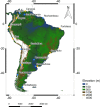Observations and Projections of Heat Waves in South America
- PMID: 31160642
- PMCID: PMC6547650
- DOI: 10.1038/s41598-019-44614-4
Observations and Projections of Heat Waves in South America
Abstract
Although Heat Waves (HWs) are expected to increase due to global warming, they are a regional phenomenon that demands for local analyses. In this paper, we assess four HW metrics (HW duration, HW frequency, HW amplitude, and number of HWs per season) as well as the share of extremely warm days (TX95, according to the 95th percentile) in South America (SA). Our analysis included observations as well as simulations from global and regional models. In particular, Regional Climate Models (RCMs) from the Coordinated Regional Climate Downscaling Experiment (CORDEX), and Global Climate Models (GCMs) from the Coupled Model Intercomparison Project Phase 5 (CMIP5) were used to project both TX95 estimates and HW metrics according to two representative concentration pathways (RCP4.5 and RCP8.5). We found that in recent decades the share of extremely warm days has at least doubled over the period December-January-February (DJF) in northern SA; less significant increases have been observed in southern SA. We also found that by midcentury, under the RCP4.5 scenario, extremely warm DJF days (as well as the number of HWs per season) are expected to increase by 5-10 times at locations close to the Equator and in the Atacama Desert. Increases are expected to be less pronounced in southern SA. Projections under the RCP8.5 scenario are more striking, particularly in tropical areas where half or more of the days could be extremely warm by midcentury.
Conflict of interest statement
The authors declare no competing interests.
Figures









References
-
- Perkins SE. A review on the scientific understanding of heatwaves—Their measurement, driving mechanisms, and changes at the global scale. Atmos. Res. 2015;164:242–267. doi: 10.1016/j.atmosres.2015.05.014. - DOI
-
- Smith A, Lott N, Vose R. The integrated surface database: Recent developments and partnerships. Bull. Am. Meteorol. Soc. 2011;92:704–708. doi: 10.1175/2011BAMS3015.1. - DOI
-
- Perkins SE, Alexander LV. On the measurement of heat waves. J. Clim. 2013;26:4500–4517. doi: 10.1175/JCLI-D-12-00383.1. - DOI
-
- Perkins SE, Alexander LV, Nairn JR. Increasing frequency, intensity and duration of observed global heatwaves and warm spells. Geophys. Res. Lett. 2012;39:L20714.
Publication types
LinkOut - more resources
Full Text Sources

